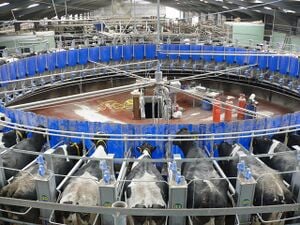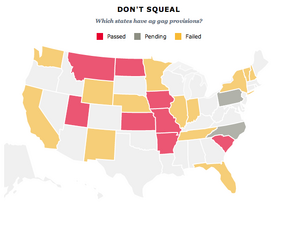
The dairy industry is a global market catering to the demand for cow, goat and to a lesser extent buffalo, camel and sheep milks as well as the various items produced from this product such as ice cream and cheese.[1] This subsistence market exists solely for human convenience, while generating human-related greenhouse gas emissions, which are directly linked to the effects of climate change.[2]
Effects on the environment[edit | edit source]
Deforestation
As of 2004 one-fifth of the Amazonian rainforestW has been cleared for purposes of cattle rearing and soybean production—largely used for cattle fodder.[3] The rate of deforestation in the Amazon has shown a pattern of decline from 2004-2009.[4] The deforestation of this ecosystem has had tremendous negative implications for the environment's biodiversityW including the loss of habitat, subsequent species population decline, endangerment and extinction as well as a loss of the forests' ability to absorb carbon dioxide, creating an altered climate within the area, and additionally, the reduction of tree growth effects the areas ability to cycle water, resulting in droughts.[5]
Air Pollution
The digestive system of ruminantsW, referred to as enteric fermentationW, produces volatile organic compoundsW and emits greenhouse gases, largely in the form of methaneW, into the air and atmosphere.[6] Methane produces a warming effect that is 20 times greater than carbon dioxide over a 100 year span.[7] Livestock accounts for 14.5 % or 7.1 gigatonnesW of the worlds total greenhouse gas emissions annually, with cattle rearing contributing to 65% of these emissions, while the dairy industry alone produces 2,123 million tonnes CO2-eq, or roughly 20%.[2] When these gases are collectively produced by a large number of bovine, such in the instances of factory farmingW, an alarming amount of pollution is generated. The rearing of livestock produces 23% of the methane emitted into the atmosphere from the United States.[2] The San Joaquin Valley, CaliforniaW is considered to be "the food basket of the world" due to the areas diversity of agricultural production. The cattle industry holds major importance to the area's economy (notably dairy farming as this area is the largest dairy region within the United States and houses the largest ice cream factory in the world), the greenhouse gas emissions produced by this industry contributes to the area's pollutionW and places it amongst the United States highest regions of air pollution, alongside Houston, Texas and Los Angles, California.[6][8]
Water
Usage: It is difficult to accurately assess how much waterW is used to produce one gallon of milk, as there are numerous variables to take into account. For instance, rainfall contributes to a percentage of the water used to raise cattle, but to distinguish what fraction of the felled water is consumed in the form of grass has produced varying assessments by accounting for all, a range of percentage or none of the rainfall within scientific study, thus generating skewed data.[6] Fresh water is a limited, precious and finite resource. AquifersW that took thousands of years to fill are being pumped for agricultural purposes at rates for which it is impossible to replenish.[6] On average for a cow to produce a single gallon of milk, she must consume four gallons of water (this figure does not take into account the amount of water it takes to keep the animal alive which falls between 40 to 50 gallons daily per cow, nor the water used to treat the waste that is generated by default).[9][10]
Treatment: WastewaterW is generated from the numerous aspects of milk production including washing and general cleaning of the facility, transportation vehicles, tanks and storage containers, collecting a mixture of milk solids, milk waste, feces, urine, detergents and sanitizers—these amounts varies depending on the size of the facility and country of origin[1].[11] Treatment of dairy related effluenceW generally occurs from the use of a heavily oxygenated environment while the treated water is then directed to surface water, effluent ponds or for use in irrigating pastures.[11] If not treated properly wastewater can have negative effects on the surrounding environment by impeding the areas ability to support aquatic life and through nitrate contamination of ground water from runoff.[11] Effluent ponds also produce methane, which accounts for nearly 25% of New Zealand's methane emissions.[12]
Media[edit | edit source]
Marketing campaigns
Considered to be one of the most influential marketing campaigns, the "got milk?" advertisements were an American effort at commoditizing and soliciting the consumption of milk, running from 1993 until February 24, 2014 when it was replaced by the slogan "Milk Life". The "got milk?" print ads were notably celebrity-focused, featuring popular musicians, actors, comedians and athletes, all endorsing the consumption of milk with a white mustache. The sales of milk throughout California saw an increase in overall consumption, though these effects were not felt as significantly elsewhere in the country W. Counter campaigns in response to this marketing include PETA'sW "got pus?" and MFA'sW "got ethics?" In an attempt to revamp milk sales, which have dwindled due to the milk alternative market, the newest campaign, "Milk Life", aims at focusing on milks suggested nutritional benefits, heavily emphasizing protein content.[13]

Limitations to media coverage
Within the United States there have been numerous bills posed to prevent the filming, photographing and general recording of factory farming. Collectively this suppression of whistleblowing is referred to "ag-gag"W and attempts to criminalize any recording of farming facilities without explicit permission.[14]
Notes[edit | edit source]
- ↑ Management of Waste From Animal Production Processing,Food and Agriculture Organization of the United Nations 1996.
- ↑ 2.0 2.1 2.2 Tackling Climate Change Through Livestock: A Global Assessment of Emissions and Mitigation Opportunities, Food and Agriculture Organization of the United Nations, 2013
- ↑ Brazil's Deforestation Worries Scientists, Brazzil Magazine, 2004. http://web.archive.org/web/20101125221557/http://brazzil.com/component/content/article/79-july-2004/2005.html)
- ↑ Estimativas Anuais Desde 1988 ate, 2009, http://web.archive.org/web/20191105220815/http://www.obt.inpe.br:80/prodes/prodes_1988_2009.htm
- ↑ Problems in the Amazon Rainforest: Forests burn, soils dwindle and people suffer, World Wide Fund for Nature. http://wwf.panda.org/what_we_do/where_we_work/amazon/problems/
- ↑ 6.0 6.1 6.2 6.3 Singer, Peter and Jim Manson (2006). The Ethics of What We Eat: Why Our Food Choices Matter. First Edition. Rodale Inc. pp 60, 233-234.
- ↑ Overview of Greenhouse Gases, United States Environmental Protection Agency.http://epa.gov/climatechange/ghgemissions/gases/ch4.html
- ↑ California's Central Valley, Merced County Regional. http://www.ftz226.co.merced.ca.us/valley/index.html
- ↑ Water Trivia Facts, Ecotech Water, LLC. http://www.ecotechwater.com/Company/watertrivia.html
- ↑ Harner, J.P. et al. "Scientific Data for Developing Water Budgets on Dairy
- ↑ 11.0 11.1 11.2 Farm Dairy Fact Sheet,Environment Bay of Plenty Regional Council. http://www.boprc.govt.nz/media/29026/FarmDairy-090526-Factsheet01.pdf
- ↑ Pratt, Chris. 2012. "Biofiltration of methane emissions from a dairy farm effluent pond". Agriculture, Ecosystems & Environments
- ↑ 'Got Milk' Dropped as National Milk Industry Changes Tactics, Ad Age. http://adage.com/article/news/milk-dropped-national-milk-industry-tactics/291819/
- ↑ Anti-Whistleblower Bills Hide Factory-Farming Abuses from the Public, Humane Society. http://www.humanesociety.org/issues/campaigns/factory_farming/fact-sheets/ag_gag.html#id=album-185&num=content-3312